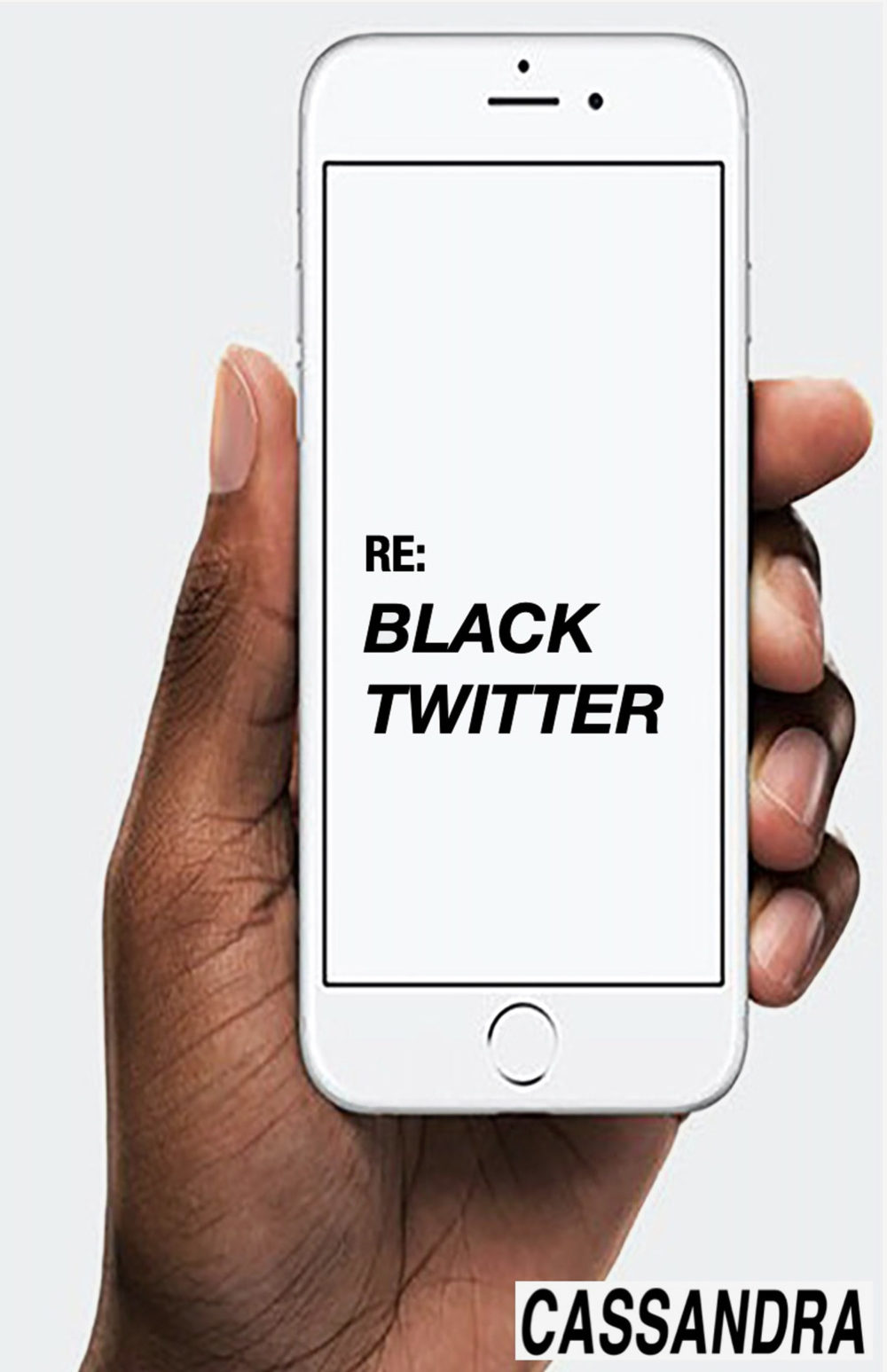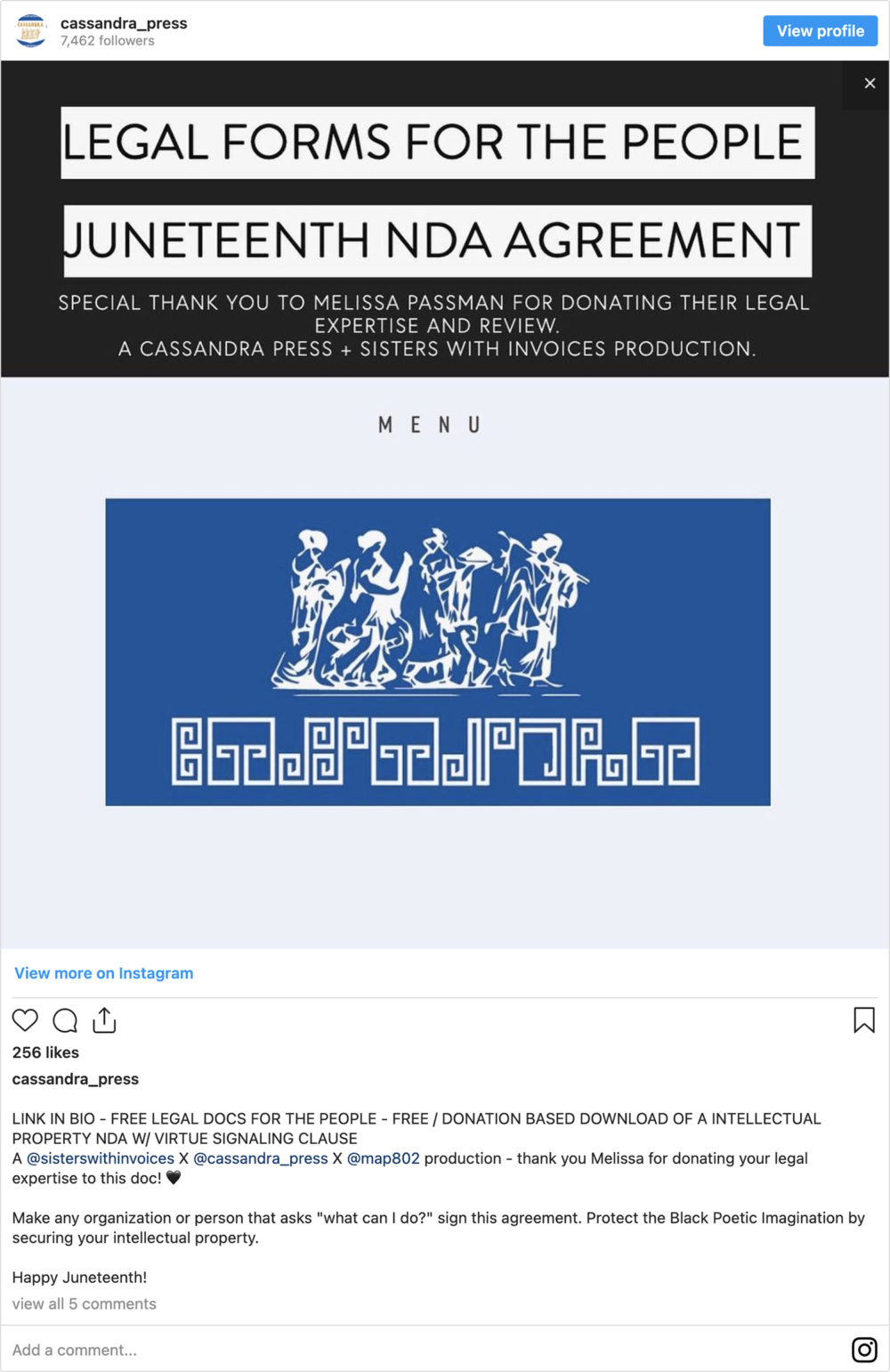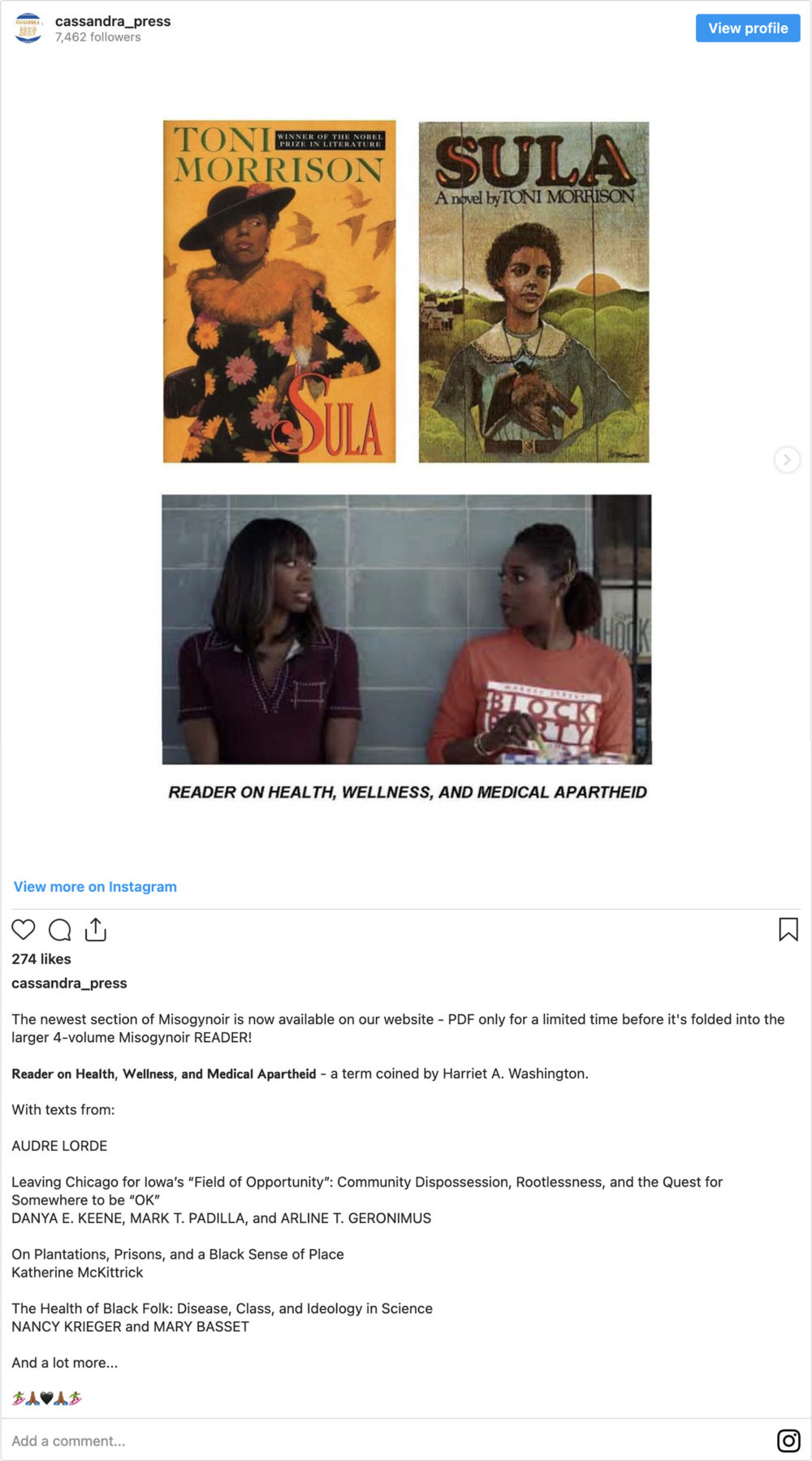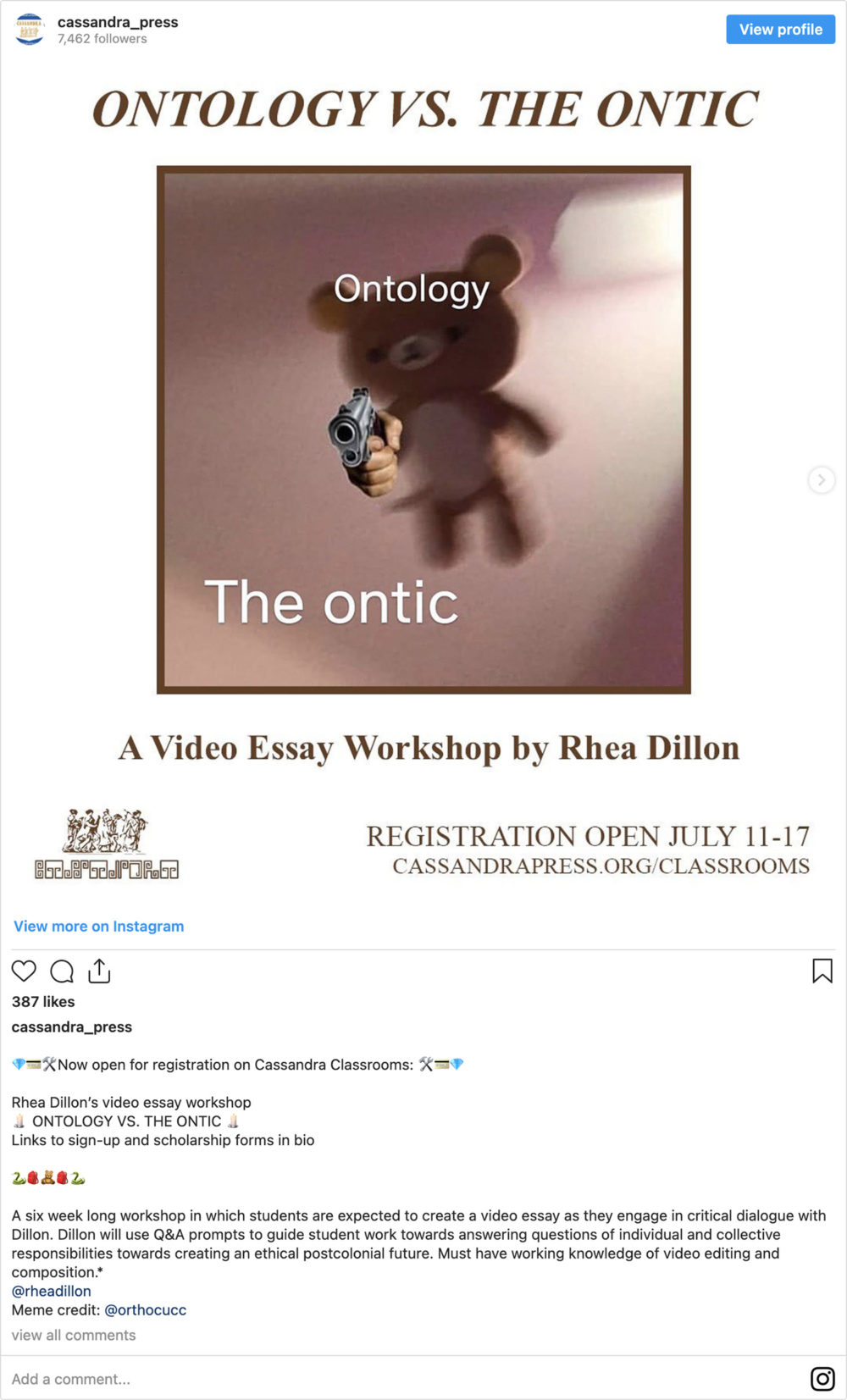- Source: W Magazine
- Author: Brooke Marine
- Date: September 2, 2020
- Format: Digital
Cassandra Press Redefines the Way Black Critical Theory Is Taught
Allow Cassandra Press founder Kandis Williams to educate you on Black scholarship with collages, zines and critical theory texts.

“RE: Black Twitter” Published by Cassandra Press. Courtesy of Kandis Williams.
In Greek mythology, Cassandra was a Trojan princess given the divine power to see the future. But she was cursed with a fate that would cause no one to believe any truth she told. Cassandra is a rhetorical device, too—you can be called “a Cassandra” if you’re someone who holds onto an accurate prophecy, but the people with whom you share it won’t trust your soothsaying.
In 2016, the artist Kandis Williams founded Cassandra Press, named in homage to the Trojan princess, with two other co-founders. The press produces lo-fi pamphlets called Readers, consisting of texts authored by Black critical theorists; holds classes; and offers artist zines at a substantially low price available for download from the site. A statement on the Cassandra Press website outlines its mission: “Our intention is to spread ideas, distribute new language, propagate dialogue-centering ethics, aesthetics, femme-driven activism, and black scholarship, because y’all ain’t listening.”
Much like the mythological Greek figure, Cassandra Press seeks to tell the truth about what is seen and recorded, and of what has been elided from history. “Cassandra [the Greek goddess myth] feels like a place where [there is] very early phenomenology around gaslighting. It’s kind of intense, the pursuance of the whole alternative reality despite certain signs, despite truths,” Williams said one day over Zoom, from her home in Los Angeles.
A Cassandra Press Reader on “Misogynoir” includes over 50 texts from Black femme writers divided into four parts. It examines the figures of the mammy, the jezebel, the sapphire, as well as a reflection on sexual violence and the legal system, colonialism, and slavery’s perversion of sexuality, and finally, the text outlines modes of resistance. A Reader on “The Chitlin Circuit” looks at the performers (Ella Fitzgerald, Redd Foxx, Moms Mabley, to name a few)—who became famous for entertaining Black audiences along the Midwest and South. There’s one about “Black Twitter,” a crash course on media theory and literacy, and critical race theory as those disciplines intersect with the social media spectacle, and there’s one on “Cannibalism, Blackface & Minstrelsy,” which includes collections of writings that connect colonial biological cannibals to contemporary modes of metaphorical cannibalism (cultural appropriation and digital blackface). These are just a few offerings from an increasingly impressive lineup, which includes Readers on topics such as performativity, Black Hollywood, Labor after Reconstruction, porn, reparations, and even “fuccboi” culture.

“I’ve always thought about the tools of perception and the dominance of certain tools,” Williams explained. “Racism is a tool of perception, and I think what we’re seeing is a deconstruction—or at least a look at—the dominance of that perceptual tool. I don’t think we’re quite there [in terms of] looking at the tool itself. Different frameworks provide cracks that we can pry open, so I’m interested in intersectionality because of those cracks and threads, and the force that different frameworks can wield to open up or shift perception.”
Williams, who works in the mediums of collage, performance, and dramaturgy, has been making Readers or something like them for a long time. But her first Reader actually stemmed from an emotional space that in hindsight she is “super not proud of.” The artist lived in Berlin for 12 years, and became friends with a group of Black women during her time there. Their romantic encounters with white, non-American men caused a lot of stress, especially when they casually asked invasive, and at times ignorant questions about race. “I remember talking with my German boyfriend at the time, and him asking me, ‘What is jive?’ or some shit like this, and just being like, ‘Yikes,’ and making a Reader. I made a Reader for us…I made a Reader for white men who were dating my friends,” she continued. “Looking back, fuck all those dudes. That wasn’t a situation of empowerment. I still don’t think they’re necessarily empowering.”
Cassandra Press doesn’t just offer Readers—there are legal documents, which are free for Black people; historically there have been issues with financial and contractual literacy in the community. Williams, who attended the Cooper Union School of Art, and has shown her work at The Studio Museum in Harlem, Neu West in Berlin, and 219 Madison in Brooklyn, has also dedicated some of her career to working in the nonprofit sphere. It was through her nonprofit work that Williams was met with NDAs and partnership agreements that she felt sought to exploit the contract signee. The Cassandra Press “Legal Docs for the People” Reader was created with the intention of calling for “more legal protection for Black bodies, a real reiteration of these more exploitative forms of capture” by providing downloadable outlines of legal forms that can protect Black intellectual property and a person’s rights to their image. “[I am] trying to be clear about how my image has been distributed and how my research has been distributed, and how to put a value on the research—not a number value, but a value—to control what I can disseminate,” she said. “It’s funny how showing people those documents really does produce a very different kind of agreement. You become immediately aware of what your stake is and what their claim is to you and what claim they’re rationalizing being able to take.”

Cassandra Press also offers courses and symposiums one can sign up to take, like a class on “Ontology vs. The Ontic” or one about “Whiteness, Dissonance and Horror,” which looks at “Whiteness and the psychology of dissonance and psychopathy bred out of white supremacist ideation via American horror films.” At a time when the educational institution is wrestling with an unprecedented global pandemic and the ways in which resources can be distributed to people who are tens of thousands of dollars in student loan debt, the virtual classroom has never been more relevant. “I’m very tall, I’m 6’2” and I’m a Black woman. People see me. I take up space. I don’t miss being in academic institutions where I have to lower my voice, or have to smile and deal with the consequences, or where I have to provocatively take up space, or reactionarily take up space,” Williams said. “That was preventing me from connecting to students and preventing me from feeling like I was learning while educating.”
Depending on the material taught in the course, Cassandra Press classes are segregated by either financial background or racial and social background because, as Williams said, “white students need a real prerequisite on how they’re seen historically, and Black students need a prerequisite on even gaining the sense of validity as authors and thinkers who have seen whiteness or seen white supremacy.” For example, with the class Williams teaches about whiteness and dissonance in horror films, there is a very real psychological threat to some of the Black students who, in a traditional institutional setting, may have to sit by as their white counterparts engage—often for the first time—with material that iterates terror acted on the Black body. “I have to separate those two groups because I don’t want to keep doing that thing to Black and Brown students where I mix the cultural imaginary and make certain students for whom it’s terrible register language of the cultural imaginary, or let students who register only the cultural imaginary just sort of voyeuristically, fetishistically consume the other, consume the terror, and then reiterate the value of that terror,” Williams explained.
It’s a radical experiment in education. “We really aren’t on the same page yet,” she said, in defense of the segregated classrooms. “This isn’t the binary, this is how to look at the binary that we have and pull it apart and say, how are we functioning in it, instead of saying, every class is a safe space. I hate the safe space shit…We have a code of conduct that’s like, this is not a link and build space, this is not a virtue-signaling space, this is a space where you’re learning how you learn so that you can keep learning,” she said. “It’s not about making more monolithic, networked, algorithmic connections for us. It’s definitely empowering the individual to relate however you already relate. To deepen your own knowledge, and deepen yourself as a site of knowledge.”
Four years after the invention of the Press (and following the dissolution of Williams’s relationships with two of her co-founders), the Reader prevails as one of the artist’s more recognizable and commodifiable endeavors, which she sells online but also at various art fairs. Williams doesn’t make these image and text collages because she loves the content therein—they are not born out of a love or affinity for pop culture, even though the subjects of many of the texts reference and analyze cultural objects and phenomena like the film Get Out or Kylie Jenner’s Forbes cover.
“I don’t respond to popular sentiment, so in terms of pop art or mainstream, it’s always been a curiosity to me,” she said. “There are some things I’m not going to fight in terms of history, too, and the Press really helps me maintain a Black community around my work.”
Making sure a Black community is the focus of and audience for the work disseminated by Cassandra Press is key for Williams as an artist. “Artists are in a really intense place because we are in service of the court,” she explained. “We’ve always been in service of the court of ‘big A’ Art. ‘Little a’ art is the only thing that resists colonialism. So we’re in a tough place with that. It’s sad to see how much of the Black death spectacle is also the Black entertainment vehicle is also the Black celebrity vehicle is also the Black abstraction [vehicle].”

The concept of abstraction exists in three forms, Williams said: the first is modern abstraction, born out of the colonial European encounter with the indigenous. The second is Black abstraction, the African-based conceptual thought (like carving an ancestor into a glyph on a rock and praying to it, or creating a family pattern to be woven for generations), and the third is Black Marxist abstraction—the conscious Black accumulation of, and destruction of systems of wealth which continuously try to rectify using Black abstraction to place a value on the Black body in culture and society. These forms work to simultaneously elevate the Black body to a symbol of avant-garde art objet (the Black nude or Black African mask) and collapse the Black body into just another corpse.
Think of a prominent cultural figure like Megan Thee Stallion, for example. Her success as an artist cannot go unrecognized (“WAP” and the proliferation of the “Savage” challenge on TikTok are just two of the many instances of the rapper’s ability to hold the attention of just about everyone with Internet access), but even still, as a Black woman, she has been exploited by the very system that claims to support her. Williams sees the music video for “WAP” as an example of the harms abstraction can do to the Black body. There is the Black abstraction Williams pointed out, which is exemplified by the rapper’s outfits in the video, likely put together by a Black designer or stylist, but it also exists in relation to the modernist abstraction Williams mentioned, which is the transformation the rapper’s body into a symbol or an object, like a chair. Both of those exist in relation to the Black Marxist mode of abstraction, too, because the musician is still a cog in the record industry machine. Before this video was even released, Megan Thee Stallion was shot in her feet, and people online laughed at her pain, reducing her to an object rather than a self-assured subject.
“We are very much traded in terms of our pelts, our skin, the honey, the gold, the cinnamon, the chai, all of those colors that are brown and also import/export objects and resources that are brown and Black,” Williams said. “We fall in and out of these metaphors and that’s one of the harms of abstraction.”
Another example in line with Williams’s thoughts on the spectacle of Black death and how that is so deeply intertwined with Black entertainment is TikTok. “I made a Reader on TikTok,” Williams said. “After being on TikTok for a year, I was like, this shit is going to precipitate a race war. It is the perfect algebra for the precipitation of anti-Black violence. To see industries that have evolved around anti-Black violence and memesis, love and hate, theft, appropriation, and destruction—they’re hand in hand throughout colonialism,” she said.
“I was fascinated with documenting performances and different registers of performances and transculturations, transubstantiations, transubjectivities around the Black voice,” Williams said. She cited three forms of “transculturation” present on TikTok: standard blackface, white girls clicking their fingernails to suggest that they are about to “go off” and white boys walking around in public wearing bathrobes and silk bonnets. “The more intimate, the editorial space that the Black body presents, the more affinity it produces for white contemplation and memetic assertion,” she explained, reminding that the popularity of this “condensation of racist caricature,” which can be quantified by the number of likes or shares embedded into each TikTok video, is nothing new. “This is American entertainment, and it’s always been laughing at singing, dancing, dying slaves.”
And then there are the Black TikTok users whom Williams sees as “igniting all kinds of amazing initiatives and doing real research, using every historical device, every comical device, every theatrical device all at once to really claim space in a global disjointed semiotic communicative form” despite the fact that they are still denied the credit they deserve for authoring these modes of performance. This app, Williams said, has “produced more discomfort for Black bodies in the world, more violence and a heightened sense of stakes of that violence.”
It can be upsetting to realize that the much-celebrated pop culture phenomenon that is the “WAP” music video might be part and parcel of this harmful form of abstraction, or that your favorite performer on TikTok might be, on some level, engaging in a centuries-long practice of global anti-Blackness, but registering that reality is the work that must be done in order to build a future that does not perpetuate global anti-Blackness. And that’s where Cassandra Press can really come in handy—by bringing radical educational tools to change your perception of what’s actually at work on a deeper level in our culture.

